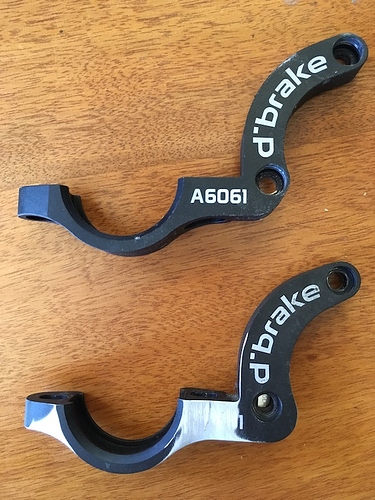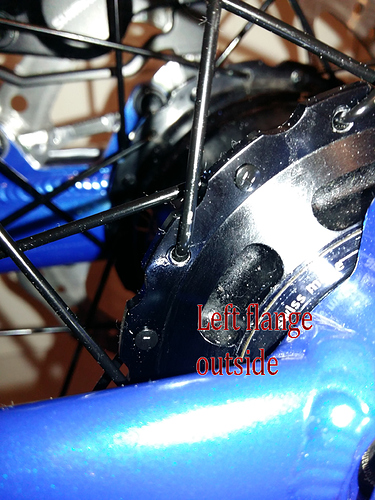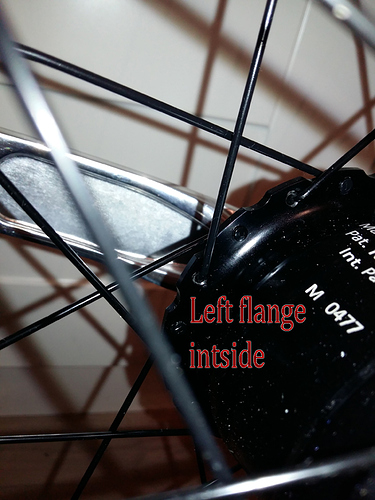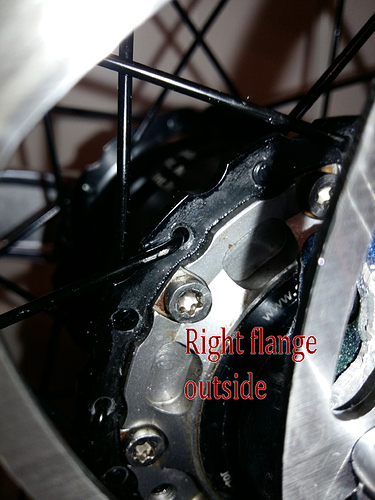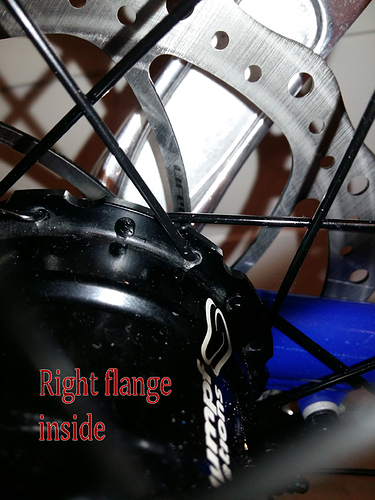since when is it available? UDC (UK and GER) only shows the standard one that I have had for years now.
I think design was improved long time ago
Here are the two dBrakes. Other than the arm profile visible in this photo they are identical. The silver on the bottom one is where I filed it to fit my 36er.
That’s a myth - the increase in tension of any one spoke is small when the wheel is under load. The only large change in tension is the decrease in tension of the bottom spokes where the rim bends slightly under the load. A bicycle/unicycle wheel is a pre-stressed structure which doesn’t quite work in the obvious way (you actually sit on the bottom spokes rather than hang from the top ones).
The significance of this is that in general too low a tension is more of a problem than too high a tension - it’s quite rare for people to build wheels with too high spoke tension, as that’s a lot higher than people think. Too low a tension can result in the spokes at the bottom going completely slack, which makes the wheel less strong and also tends to result in the nipple unscrewing and you losing all wheel tension.
There is one obvious exception to that, which needs mentioning on a Schlumpf thread. I think most/all of you have relatively recent Schlumpf hubs, but I have a first generation hub and broke the flange when rebuilding the wheel by overtensioning the spokes (they wouldn’t have been overtensioned on a normal hub - I was just bringing them up to the same tension I have on bike wheels with similar rims - but you have to use lower tension with first gen Schlumpfs).
Just had a go on a G28 earlier today, what a hoot! Took a couple of seconds to get used to the much larger feeling wheel (which wasn’t too hard as I’d just got off a 36"). But after that I quickly figured out freemounting in the higher gear.
Tyre was running at 60PSI, which, coupled with the way smaller wheel, feels incredibly responsive. I’m hooked! Really want to build some geared system now…
I have now built the Schlumpf/29 Dominator2 wheel I was writing about earlier. My concern now is whether lacing the wheel with the trailing spokes running on the outside of the flange will affect the hub. You can see the whole discussion from post #7 in the wheelbuilding thread I started in the articles/tutorials section (Wheelbuilding - experience of a novice who didn't want to read a book). What have other Schlumpf owners done? Thoghts on the subject?
I don’t think it really matters because the forces will never be as important as on a hub on a bike/motorbike going full speed and slamming the brakes. Also, the efforts are not only on one side of the hub like on a bike (or a uni with internal disc brake), but they are on both sides as it’s activated from the center.
Maybe you could build an asymmetrical wheel, as shown on the Shimano pix you linked in your other thread:
But following the pix on the right for both sides since if you install a crank brake, it would be on the right side.
Lot of good info in that link where I also found the Shimano recommendation pix.
If the hub has been previously built, always try and match what the previous builder did (you’ll see the divots from the spoke elbow at each hole).
If it’s new, do what’s easiest for you. It’s been done both ways forever and has little difference.
If you follow Sheldon Brown’s tutorial, he goes into some depth about this and explains how doing it in the order he prescribes is a bit easier to lace.
Since the wheel us built, leave it alone.
I looked for a Schlumpf tech doc on lacing (I was looking to see if asked for a specific lacing pattern, such as Rohloff’s 2x) but I didn’t see any information. The only info was to put the spoke head in the recessed side of the flange hole and the spoke lengths recommended were for 3x lacing. I think this would be more important than trailing/leading spokes. (If you go look around at a whole bunch of bicycle wheels, you will see lots of different patterns of trailing and leading spokes on either side of the bike and they all work reasonably well, albeit, there might be a “best” way, esp. with disc brakes.) If it were a bigger issue, it would be a safety concern with riding your front wheel “backwards” on a regular bicycle, but mechanics are more worried about what side the quick-release is on instead of the direction of pulling spokes on the wheel.
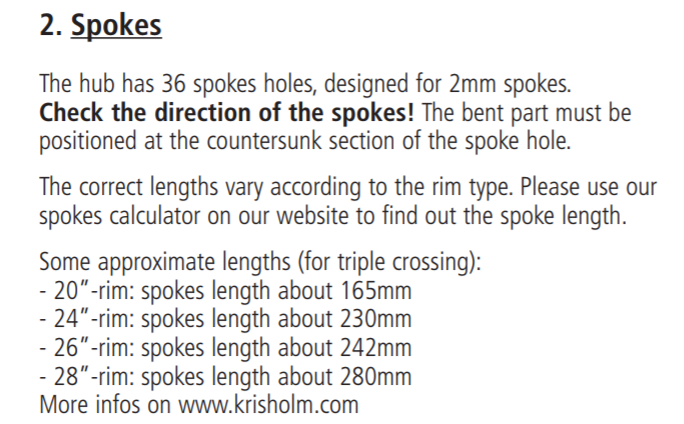
It looks like I got this wrong. I need a few days break from this project now. I also struggled quite a bit with the disc brake. Thanks for the info.
No - if you’ve got the spoke head on the non-recessed side you’ve got it right - that advice is wrong (and the quoted advice from Schlumpf directly contradicts it - you put the head on the non-recessed side so that the bend is on the recessed side).
Though I thought the design had changed so that both sides are now countersunk, or do you have an old hub?
I bought my Schlumpf hub in 2011. It is number 0477 - I don’t know which version that is. I looked at it yesterday and it was hard to tell with the spokes in place. I’ll take a picture later, maybe someone here can tell if it is right or wrong.
It’s been several years since I last rode a guni (g26), but I tested it briefly yesterday. With the 137 cranks, shifting up was pretty easy. Staying on in high gear was not. I don’t think I’ll ever put this hub in a 36’er.
I think it’s at least the second revision, the sturdy ones with more bearings than the first couple of series. I also think it’s a version where the spoke holes have a recessed area drilled on both sides of the hub. A photo will indeed clarify.
You’re not the first one saying that… before it happens! ![]()
I have been riding guni for almost two years now and I feel like i’m still learning to ride it.
Started with a g26 with a slick and light tire, then a 26x3.
After between 500 and 1000 miles I built a g29+ with it and finally, after few hundreds of miles I decided I prefer 36x150 over g29+x137 so I built a g36, still from the same hub.
My observation is this: the bigger and heavier the wheel is, the more stable and natural it feels to ride in high gear.
shifting up may be another story.
I find the 36er more intimidating when I am about to shift up because of the height and the higher speed I reach before I shift up.
The trick is to lean a bit forward (rather that keeping the center of gravity behind the wheel which tends to interrupt the pedaling flow), riding at about 10-11mph and doing my best not to discontinue the pedaling cadence/stroke/flow while (and just after) I hit the high gear button.
My smoother shifting up transitions are when I accidentally shift up while riding down a curb: since I don’t see it coming I don’t unconsciously anticipate it by putting some pressure on the back pedal nor slowing down the cadence.
Also the speed you reach in high gear while pedaling not so fast is proportionally higher on a g36 than a g26, the crashes may be epic too for people of our ages.
There is no such thing as too much protective gear.
A good amount of miles in high gear with your less stable but less dangerous g26/g29 (not sure which one you test-rode yesterday) would be a good thing before you decide if you want to make a g36 or not.
Also some people ride a g36 without handlebars.
Personally I tested short handlebars, long, and two positions short+long handlebars.
The short one helps during the shifting (up or down) process and while riding in high gear on bad floors.
The long one helps while riding fast in low gear or fast in high gear on clean paths/roads/bikepaths, it brings more stability and makes it easier to pedal.
The short+long solution brings the best of the two worlds, but you have to DIY it.
Edit: my DIY short+long handlebar :
My Schlumpf buy was really a mistake. I bought it because I thought it would be practical and because I was curious. I thought i would be great to ride it to the trails in high gear and then go off road in low gear. But it’s up hill almost all the way to the trail head and it’s bit heavy for muni, so it has collected dust for years. I prefer to strap a muni to a bicycle rather than to ride a 26 guni. Now I want to try it again just for fun, and for that purpose I think a 29’er may be better suited than a 26’er. But a 36? No way!
Here are pictures of my hub. Looks like I didn’t get the spokes in the same way as it was before(?). The spoke holes seems to be countersunk on both side of the flange. I’m not 100% sure.
For which exact reason?
If it’s speed I must say I’m am not faster on my G36x150 than I was on the G29x137, The fastest speed I ever dared to reach on the G29 was 29.4 km/h, on the G36, my very first time on it I reached 30.7km/h, never managed (dared) to reach again but it didn’t feel as dangerous as my top speed on the G29.
my typical riding speeds in high gear are the same on the G36 as there were on the G29 :in the 20-27 km/h range.
The difference is : it feels more stable on the big wheel and I don’t have to spin the pedals as fast to reach the exact same speed.
The big difference is the 1:1 : in fact I don’t ride very often in high gear on the G36, my loops usually are too complicated for that, but in the other hand I don’t really need it to reach the same average speed as with the G29 with which I was shifting up and down more often.
After a ride on a 36x150 (ungeared) the 1:1 of the 29 felt slow and only useful on the uphills, while the 1:1 in the G36 feels like a real effective gear but still able to manage uphills and complicated situations at very slow speed.
I agree with you, I don’t find it very good for muni, it’s heavy and I often had accidental up shifts on small drops, some very good riders use it road and muni though.
For all those reasons I decided to make a G36, to have a bigger wheel in high gear for the money, but I wouldn’t buy it again if I was returning 2 years in the past.
I also built my wheel without taking in account how the previous owned had it laced, that’s my second wheel building with the same hub, I have no issues though.
The two spokes around the valve hole must move away from each other.
a typical mistake in the key spoke choice and overall lacing often results in a valve hole that sees the two spokes around going toward each other.
Yes, because when i rode the g26 I remember thinking that a g36 would be way to fast. If I had lived a place where the terrain was flat, I might have been willing to give it a try. I suspect that this new G29 will not be the one I use the most, but we’ll see.
I got the valve hole right, and unless someone can see from the pictures that it is done wrong, I’ll keep it as it is.
Looks fine.
High gear start vs shifting
Is it more difficult to start in high gear or shift while riding? I’m thinking about a Schlumpf hub for road use and alternatively have designed a simpler high speed only hub. Would a high speed only hub be ok for road? Thinking about a 24" rim to learn on then maybe a 29. I pretty much just ride muni now, but am interested in some longer road rides when the trails are closed for mud.
